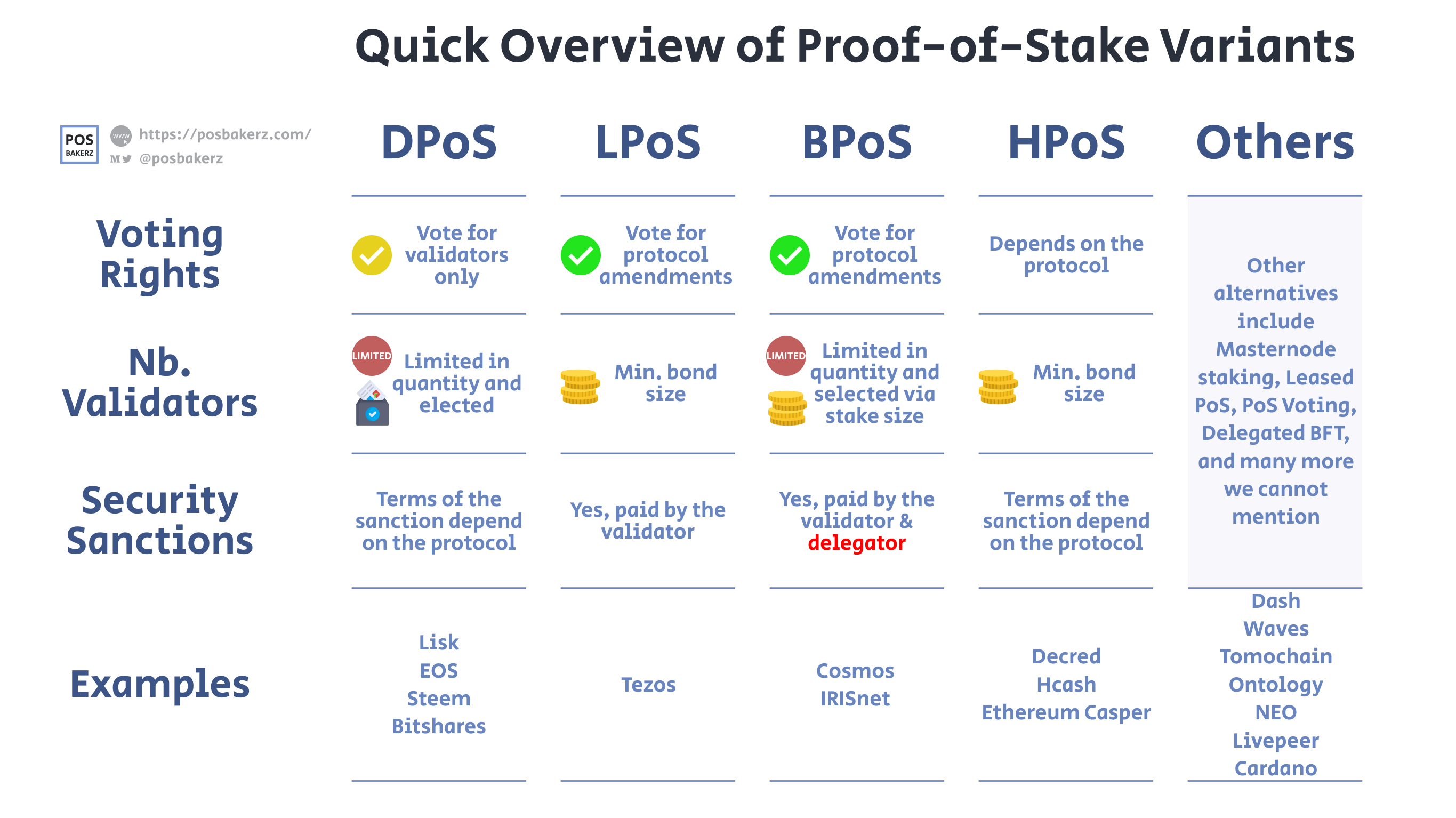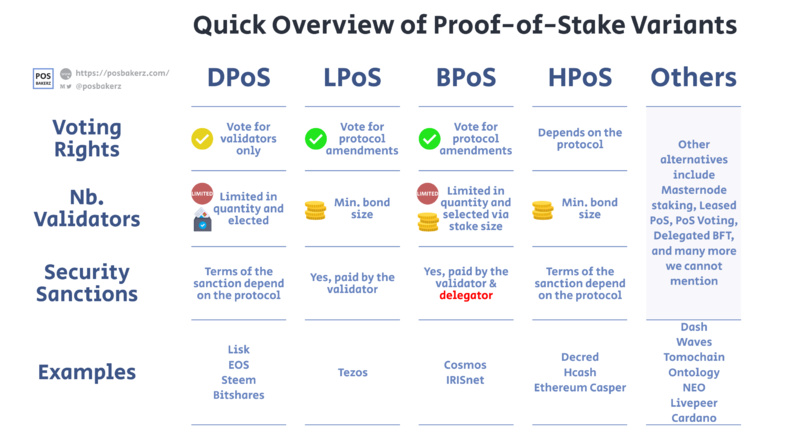Proof-of-Stake, often described in comparison to Proof-of-Work (PoW), is a process through which network validators are incentivized based on the number of tokens they own. At Stakin, we’re very bullish on the future of Proof-of-Stake cryptocurrencies we believe that it offers the following pros:
- Less computing power intensive than PoW: we run a few staking nodes on various PoS protocols, and to do so we only have a few secured VPS vs. tons of mining rigs for PoW miners.
- Token Holders can earn rewards/interests based on the inflation rate: this can help in the build-up of the community, but also incentivize people to hold on to their token.
- Decentralization: depending on which kind of PoS the protocol has adopted, the network can reach full decentralization, which is the initial reason why cryptocurrencies were created.
- Less computing power intensive than PoW: we run a few staking nodes on various PoS protocols, and to do so we only have a few secured VPS vs. tons of mining rigs for PoW miners.
- Token Holders can earn rewards/interests based on the inflation rate: this can help in the build-up of the community, but also incentivize people to hold on to their token.
- Decentralization: depending on which kind of PoS the protocol has adopted, the network can reach full decentralization, which is the initial reason why cryptocurrencies were created.

A beautiful datacenter
In the following sections, we will introduce you to various PoS variants, detailing how they work, and then provide you with a simple recap table. For simplification purpose, validator designates the nodes that secure and verify transactions on the network in exchange for token remuneration. Depending on the protocol, these can also be called block producers, witnesses or bakers.
Delegated Proof-of-Stake (DPoS)
DPoS usually works through an election system, in which a fixed number of validators are authorized to secure the network. As a token holder, you get to vote on who will validate transactions on the network, with voting power determined on the size of your stake 🐳 > 🐟. The validators with the most votes get to become delegates, validating transactions and collecting rewards for doing so.
DPoS has been implemented on protocols such as Lisk, Tron, Steem, Bitshares or even EOS, a scalable blockchain Dapp platform founded by Daniel Larimer and mostly known for its record year-long $4bn ICO 💰. Depending on the protocol, DPoS can require significant computing power for the validator.
Liquid Proof-of-Stake (LPoS)
In LPoS, delegation is optional. Token holders can delegate validation rights to other token holders without custody, meaning that the tokens remain in the delegators’ wallet. Additionally, only the validator is penalized in case of security fault (e.g. double-endorsing or double-baking). LPoS also offer voting rights, except that as a token holder you get to vote directly in the protocol amendments, and not only in who secures the network like in DPoS.
LPoS was first introduced by Tezos, an on-chain governance protocol, created by Kathleen and Arthur Breitman, which has been running smoothly in mainnet since September 2018. LPoS in Tezos has proven to be very successful, with a current stake rate of approximately 80% spread across 450 validators and 13,000 delegators. The number of delegators is technically limited by the bond size minimum requirement, and with current parameters could go up to around 70,000 — Great decentralization 🏆.
Bonded Proof-of-Stake (BPoS)
BPoS is very similar to LPoS: delegation is optional, non-custodial, and token holders benefit from voting rights in protocol amendments. Although, there is a reason why it is called BPoS: in case of safety or liveness fault, a portion of the validators and delegators’ stake will be slashed. In LPoS, only the validator is at risk of slashing, while the delegator’s only risk is to miss on some rewards/interests in case its validator is dishonest or not efficient.
This BPoS mechanism has the advantage of providing a clear solution to the issue of staking ratios (similar to capital requirements) that some validators on LPoS protocols have to maintain if they do not want to become over-delegated and disappoint some of their delegators. While it solves this issue, it also means that delegators need to conduct extra due diligence before delegating, and remain active in verifying the performance of their validator.
BPoS was first introduced by projects such as Cosmos and IRISnet (which build on the Cosmos SDK / Tendermint). Both are very interesting inter-chain protocols to have a look at 🚀. We’ve written a short introduction to IRISnet if you are curious. In BPoS protocols such as Cosmos and IRISnet, there will be a limited number of validators, starting at 100, with selection based on the size of their total stake (own stake + delegations).
Hybrid Proof-of-Stake (HPoS)
Hybrid PoS/PoW is often referred to as a mix between Proof-of-Work and Proof-of-Stake. It is a way to secure the network using both of these methods: the PoS works alongside the PoW system to further secure the blockchain. Usually, in such implementation, miners produce new blocks via PoW, and PoS validators then vote on the validity of these. HPoS provides a superior deterrent to majority attacks by augmenting hashing power with stakeholder voting.
Among the projects working on HPoS, we can name Decred and Hcash. Ethereum is also looking at HPoS for its Casper upgrade. In Decred, token holders have the ability to check the blocks found by miners and to vote on changes to the consensus rules.
Others That Can Be Assimilated to PoS
Our goal in this article is to provide you with an overall overview and keys to understand the various PoS protocols. As PoS is gaining interest across the overall blockchain industry, we would like to mention some other projects that also offer staking, although with their own variant:
• Waves: Leased Proof-of-Stake (Leased PoS)
• Tomochain: Proof-of-Stake Voting (PoSV)
• Dash: Masternode staking
• Ontology: Delegated Byzantine Fault Tolerance with ONG “dividends”
• Neo: Delegated Byzantine Fault Tolerance with GAS “dividends”
• For the one that we did not mention, add them in comments 😉
Delegated Proof-of-Stake (DPoS)
DPoS usually works through an election system, in which a fixed number of validators are authorized to secure the network. As a token holder, you get to vote on who will validate transactions on the network, with voting power determined on the size of your stake 🐳 > 🐟. The validators with the most votes get to become delegates, validating transactions and collecting rewards for doing so.
DPoS has been implemented on protocols such as Lisk, Tron, Steem, Bitshares or even EOS, a scalable blockchain Dapp platform founded by Daniel Larimer and mostly known for its record year-long $4bn ICO 💰. Depending on the protocol, DPoS can require significant computing power for the validator.
Liquid Proof-of-Stake (LPoS)
In LPoS, delegation is optional. Token holders can delegate validation rights to other token holders without custody, meaning that the tokens remain in the delegators’ wallet. Additionally, only the validator is penalized in case of security fault (e.g. double-endorsing or double-baking). LPoS also offer voting rights, except that as a token holder you get to vote directly in the protocol amendments, and not only in who secures the network like in DPoS.
LPoS was first introduced by Tezos, an on-chain governance protocol, created by Kathleen and Arthur Breitman, which has been running smoothly in mainnet since September 2018. LPoS in Tezos has proven to be very successful, with a current stake rate of approximately 80% spread across 450 validators and 13,000 delegators. The number of delegators is technically limited by the bond size minimum requirement, and with current parameters could go up to around 70,000 — Great decentralization 🏆.
Bonded Proof-of-Stake (BPoS)
BPoS is very similar to LPoS: delegation is optional, non-custodial, and token holders benefit from voting rights in protocol amendments. Although, there is a reason why it is called BPoS: in case of safety or liveness fault, a portion of the validators and delegators’ stake will be slashed. In LPoS, only the validator is at risk of slashing, while the delegator’s only risk is to miss on some rewards/interests in case its validator is dishonest or not efficient.
This BPoS mechanism has the advantage of providing a clear solution to the issue of staking ratios (similar to capital requirements) that some validators on LPoS protocols have to maintain if they do not want to become over-delegated and disappoint some of their delegators. While it solves this issue, it also means that delegators need to conduct extra due diligence before delegating, and remain active in verifying the performance of their validator.
BPoS was first introduced by projects such as Cosmos and IRISnet (which build on the Cosmos SDK / Tendermint). Both are very interesting inter-chain protocols to have a look at 🚀. We’ve written a short introduction to IRISnet if you are curious. In BPoS protocols such as Cosmos and IRISnet, there will be a limited number of validators, starting at 100, with selection based on the size of their total stake (own stake + delegations).
Hybrid Proof-of-Stake (HPoS)
Hybrid PoS/PoW is often referred to as a mix between Proof-of-Work and Proof-of-Stake. It is a way to secure the network using both of these methods: the PoS works alongside the PoW system to further secure the blockchain. Usually, in such implementation, miners produce new blocks via PoW, and PoS validators then vote on the validity of these. HPoS provides a superior deterrent to majority attacks by augmenting hashing power with stakeholder voting.
Among the projects working on HPoS, we can name Decred and Hcash. Ethereum is also looking at HPoS for its Casper upgrade. In Decred, token holders have the ability to check the blocks found by miners and to vote on changes to the consensus rules.
Others That Can Be Assimilated to PoS
Our goal in this article is to provide you with an overall overview and keys to understand the various PoS protocols. As PoS is gaining interest across the overall blockchain industry, we would like to mention some other projects that also offer staking, although with their own variant:
• Waves: Leased Proof-of-Stake (Leased PoS)
• Tomochain: Proof-of-Stake Voting (PoSV)
• Dash: Masternode staking
• Ontology: Delegated Byzantine Fault Tolerance with ONG “dividends”
• Neo: Delegated Byzantine Fault Tolerance with GAS “dividends”
• For the one that we did not mention, add them in comments 😉
Conclusion
We believe that we will see more variant of Proof-of-Stake emerge in the future as the creativity of the talent pool working behind blockchain is quasi-infinite. It has now become clearer that PoS cannot be ignored as one of the best tested and viable alternatives to other consensus mechanisms such as PoW. With the rise of PoS, a multitude of staking-as-a-service providers is also emerging, and we recommend that you, as a token holder, do not miss out on your interests: taking into account compounding, these can increase pretty fast. If you are looking for a trusted validator, we’ll be more than happy to advise you and help you earn rewards on your crypto holdings. Feel free to reach out to us, we are Stakin
We believe that we will see more variant of Proof-of-Stake emerge in the future as the creativity of the talent pool working behind blockchain is quasi-infinite. It has now become clearer that PoS cannot be ignored as one of the best tested and viable alternatives to other consensus mechanisms such as PoW. With the rise of PoS, a multitude of staking-as-a-service providers is also emerging, and we recommend that you, as a token holder, do not miss out on your interests: taking into account compounding, these can increase pretty fast. If you are looking for a trusted validator, we’ll be more than happy to advise you and help you earn rewards on your crypto holdings. Feel free to reach out to us, we are Stakin
Finyear & Chaineum
Lisez gratuitement le quotidien Finyear & sa newsletter quotidienne.
Recevez chaque matin par mail la newsletter Finyear, une sélection quotidienne des meilleures infos et expertises en finance digitale, corporate finance & crypto finance.
Read for free The daily newspaper Finyear & its daily newsletter.
Receive the Finyear's newsletter every morning by email, a daily snapshot of the best news and expertise in digital finance, corporate finance & crypto finance.
----------------
Chaineum - Conseil haut de bilan & stratégie blockchain
Conseil en opérations de haut de bilan : ICO STO advisory, levée de fonds, M&A.
Conseil, stratégie & accompagnement de projets en technologie blockchain.
Besançon - Paris + réseau international de partenaires.
Recevez chaque matin par mail la newsletter Finyear, une sélection quotidienne des meilleures infos et expertises en finance digitale, corporate finance & crypto finance.
Read for free The daily newspaper Finyear & its daily newsletter.
Receive the Finyear's newsletter every morning by email, a daily snapshot of the best news and expertise in digital finance, corporate finance & crypto finance.
----------------
Chaineum - Conseil haut de bilan & stratégie blockchain
Conseil en opérations de haut de bilan : ICO STO advisory, levée de fonds, M&A.
Conseil, stratégie & accompagnement de projets en technologie blockchain.
Besançon - Paris + réseau international de partenaires.
Autres articles
-
Pomelo annonce une Série A à 35 millions de dollars menée par Vy Capital
-
Hong Kong : bientôt des premiers ETF Bitcoin ?
-
TMS Network (TMSN) Powers Up As Cryptocurrency Domain Appears Unstoppable. What Does This Mean For Dogecoin (DOGE) and Solana (SOL)?
-
The Growing Popularity of Crypto Payments: Could TMS Network (TMSN), Alchemy Pay (ACH), and Ripple (XRP) Lead The Way Despite The Whales?
-
DigiFT DEX Raises $10.5M in Pre-Series A Funding Led by Shanda Group

















